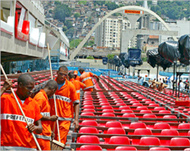Nazi dancers trouble Brazil carnival
After the polemic caused by Prince Harry’s Nazi fancy dress episode comes another questionable party outfit – dancing Nazis at Brazil’s world famous carnival in Rio de Janeiro.

Samba group Beija-Flor will parade this week performing a choreographed routine with dozens of its members dressed as Hitler’s soldiers giving a Nazi salute at the city’s centrepiece Sambadrome.
The stadium will be packed with Brazil’s glitterati. Thousands of tourists will be paying up to $1000 a ticket for the experience which will be transmitted live on television as the country closes down for four days of revelry.
“The samba school decided to remember some barbarities. I thought it would be valid to mix the Nazis, who committed the worst atrocity in the search for a pure race, with Roman soldiers,” says Hilton Castro, the group’s choreographer.
Seventy men, the majority black, will be dressed up as centurions and Nazis will represent soldiers commanded by Herodes sent to kill Jesus. They will give a version of the Nazi salute but with a closed fist and not an open hand.
“I opted for the closed hand because it seemed stronger. Before we tried with the open hand but the result wasn’t so good. I’m not concerned about this detail.
“Hitler’s army was a big inspiration for this work. There is no apology to Nazism in the choreography,” he said.
Police action
Another samba school in Sao Paulo was forced to remove a reference to Hitler in their carnival song I Too am Immortal in November after police stepped in.
The group Vai-Vai (Go-go), who with Beija-Flor (Hummingbird) make the Manchester United and Real Madrid of the carnival world, had name-checked Hitler along with Jesus, Buddha and Ghandi as people to be remembered and immortalised.
 |
|
The purpose built Sambadrome |
Jayme Blay, president of Grade, the police body which investigates crimes of intolerance, said: “You can’t put a murderer by the side of figures loved by humanity. This type of mention is offensive to the memory of all of those who died. It’s an extremely sensitive subject.”
Vai-Vai withdrew the reference and apologised to the Jewish community, but without adequately explaining the original inclusion.
“We didn’t imagine we could be badly interpreted. We are sorry if we offended anyone,” said Vai-Vai’s director Claricio Aparecido Goncalves.
Unintentional offence
There are about 130,000 Jews living in Brazil, mostly clustered in the three biggest southern cities of Rio de Janiro, Sao Paulo and Porto Alegre.
 |
|
The carnival king, or lord of |
The Nazi references of the two samba giants appear to be coincidence. Brazil has traditionally been a land of tolerance with no history of anti-Semitism.
At the huge street rehearsals there is no trace of neo-Nazi groups, such as the Juventude Nacionalista Brasileira, who were initially blamed by police in Sao Paulo during a spate of killings of street homeless people in August last year. For one thing, the vast majority of the samba school’s members are black or of mixed race.
The country sent troops to fight alongside the Allies in the second world war.
Nazi retreat
But Brazil, along with Paraguay and Argentina, became a haven for fleeing Nazis after the war.
 |
|
After the second world war Nazis |
About 1500 Nazis are thought to have entered Brazil in the 1940s and 1950s.
The most infamous, Nazi doctor Josef Mengele, spent the past 19 years of his life in the country. Long-lost letters and dairies detailing his everyday life surfaced at a Sao Paulo police station last November and were widely published.
In Brazil the Nazi references have barely been reported. Instead, as the world’s biggest Catholic country, the subjects that always draw fire are any toying with religious symbols.
International audience
This year is no exception. Once again it is Beija-Flor, with an image of a bloodied Christ wearing an indigenous Indian costume, which has angered the Catholic church.
The parades and theatrical themes are treated seriously in a highly competitive atmosphere among the vast number of samba schools who try to outdo each other each year with the most outrageous or flamboyant display.
 |
|
The carnival attracts thousands |
Rio’s modern day carnival is a highly commercialised affair, attracting big money in sponsorship and TV deals.
But the city is witnessing a return to its roots which sees the corporate antipathy of what carnival is all about – a spontaneous outpouring of celebration in streets and neighbourhoods.
The size and scale of each bloco party vary enormously but with the emphasis firmly on participation and fun. On Copacabana beach you can samba with the Bip Bip bloco who simply pile out of a bar of the same name at the stroke of midnight without a rehearsal in sight. You can dance away with them or the bohemians of the Carmelitas in from the Santa Teresa artists neighbourhood.
This year there’s even a carnival bloco for the workers and users of the mental health unit of Rio’s Psychiatric Unit, called You are Going Crazy, You are Crazy, You’ve Gone Crazy.